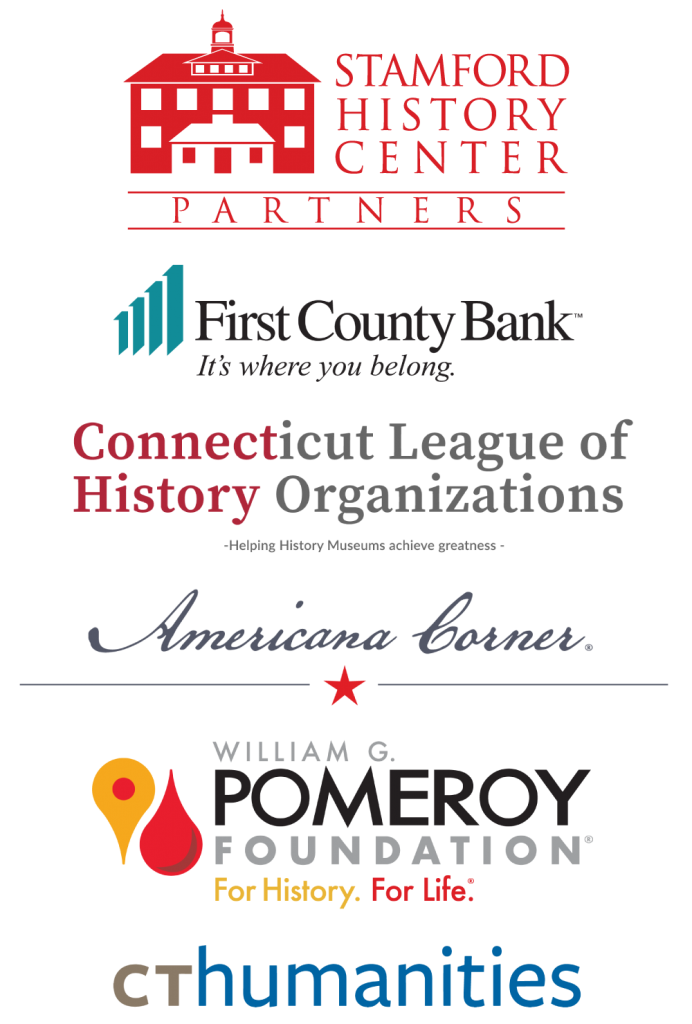Introduction
by Thomas A. Zoubek, Ph.D., Executive Director, Stamford Historical Society
This exhibit examines the history of the Greater Stamford area from its settling in 1640 through to the 20th century and traces the development of the community of Stamford from its agrarian beginnings through its industrial and corporate periods. The Davenports provide an ideal foil through which to view local history, as this family was intimately connected with the community of Stamford for over 300 years and provided family members who served significant roles in each phase of Stamford’s development. A number of themes guide the exhibit. These are woven into the chronological presentation. The key themes for the Colonial Period are the power of the New Haven Colony and the Congregational Church over daily life. John Davenport of Stamford emerges as the central figure in maintaining conservatism. The themes for the post-Revolutionary period are the increasing political role of Stamford, championed by Abraham Davenport; the increasing commercial importance of Stamford as a supplier for New York and center for transportation, eventually serving also as a main stop of the rail line; and ultimately, the conversion of Stamford into an industrial center.
The Establishment of Stamford as an Agrarian Outpost of New Haven
Stamford was founded through the work of Rev. John Davenport of New Haven, who interceded in the conflict of the Wethersfield settlers. The New Haven Colony had acquired the lands that were to become Stamford in 1640. With the settlement of the Wethersfield dissenters in the area by late 1641 New Haven succeeded in extending its control along the Connecticut shoreline and providing a buffer between it and the Dutch in New York.
The Maintenance of the Congregational Church as the Organizational Focus
From the inception of the community the town’s center was the church that provided not only spiritual but also secular leadership in the affairs of the town. From 1693 to 1732, the Rev. John Davenport, grandson of John of New Haven, led the church as the second pastor. His contributions extended beyond Stamford as he was also one of the key contributors to the Saybrook Platform. During John’s tenure the church grew in membership and to a great extent governed the lives of Stamford’s populace. The town continued to expand in population throughout this time, but remained essentially agrarian. When John III came to Stamford, there were fewer than 500 souls, and by the time he left, the population had more than doubled, there being 1510 people in Stamford by 1745.
The Pre-Revolutionary Period and The Revolution and Its Aftermath
There were a number of significant Davenports in the 18th and early 19th centuries who contributed greatly to the development of the town as a key center of local governance. Abraham Davenport served not only as a member of Stamford’s local government, but also fulfilled duties in the state government and as an officer during the Revolutionary War. He was also a key advisor to Governor Trumbull and served on the Council of Safety. His brother James was one of the leading proponents of the New Lights, who sought to reform the Congregational Church during the latter 1730s and 1740s. Abraham’s sons John and James both served in the Federal Government from the conclusion of the Revolution through the 14th Congress. These men also continued to serve in local posts and were pillars of the Congregational Church.
The Industrialization and Commercialization of Stamford During the 19th Century
During the 19th century Stamford changed from a mostly agrarian community of subsistence farmers to a manufacturing center. The Post Road was rebuilt through town and a postal station was placed in Stamford. Some firms grew to be worldwide in scope, such as Yale & Towne Lock Manufacturing (founded 1869) or the Stamford Manufacturing Company at Cove Island (reorganized in 1844). Amongst these firms were the Stillwater Rolling Mills, owned and managed by the Davenport family. The mills played an important role in driving the local economy by providing jobs to immigrants, who began to arrive in great numbers after the completion of the railroad in 1848. The mills also were crucial to supplying the Union war effort during the Civil War.
The Development of Stamford as a Center of Banking
The Theodores Davenport, father and son, were central to the founding of the Stamford Savings Bank, now First County Bank. Both served on local boards of governance throughout the 19th century and were involved in planning the growth of Stamford’s downtown during this time period. Later John Davenport and Charles Davenport Lockwood followed as prominent officials of Stamford’s banking sector.
Stamford in the Early 20th Century
As Stamford entered the 20th century, the Davenports continued to play a key role in the community’s development and transformation. One of the most important institutions with Davenport roots is the legal firm of Cummings & Lockwood, Judge Charles Davenport Lockwood being one of the founding partners. This firm grew to be one of the most respected in the City. Davenports continued also to play into the social life of the town, as they had since the 1700’s. One, Butler Davenport, for example, ran a summer theater on Davenport Ridge Road during the 1920s for locals.
The Continuing Legacy…
The Davenport name in Stamford is everywhere … Davenport Lane, Davenport Ridge Road, Davenport Ridge School, etc. Cummings & Lockwood and First County Bank continue to serve the public. It is appropriate that the Davenport name be one honored by the town, as the Davenports contributed so much to shaping the City that Stamford now is. At each juncture of Stamford’s history, a Davenport was at the helm, thus making an exhibit using this family as a lens through which to view Stamford appropriate and timely. |
(The Founder)
(The Benefactress)
|
| The featured speaker at the opening was , a noted scholar of early Colonial America, who is writing a book on Reverend John Davenport of New Haven. His lecture was titled .
The Stamford Historical Society received a from the for this exhibit.
The Stamford Historical Society is indebted to Elizabeth Davenport Spence. From 1973 until her death in 1998, Mrs. Spence gave the Stamford Historical Society a large collection of Davenport items including furniture, paintings, silver, textiles, books, photographs and archival materials relating to the history of the Davenport family. The Society deeply appreciates her great interest in Stamford history and her generous donations, without which this exhibit could not have been possible in its current form.
This exhibit is made possible through the generous support of
THE F. A. BARTLETT TREE EXPERT COMPANY
BENEFACTORS
First County Bank
William Raveis Real Estate & Home Services
Charles and Margaret Bowen
Suzann Emmens
Jane C. Flounders
Irene Hahn
Judge Guido Alphonso Loyola
Douglas B. Nelson & Gilbert B. Wheless
ACKNOWLEDGEMENTS
Academy for Information Technology
Reverend Gary Brown
Cooley Communications
Creative Framing & Gallery
Guy DeMasi Painting
Raphael’s Furniture Restoration
Scalamandré
SPECIAL ACKNOWLEDGEMENT
Cummings & Lockwood: for the gift of the painting of Judge Charles Davenport Lockwood
Byrd Davenport: for the gift of a digitally reproduced Drawn Neoclassical Profile Portrait of John Davenport 1752–1830
LENDERS
Amherst College
Mrs. Carol Beauregard
Laurel and Francis Cooley
Mary Ann and Edna H. Crandall
Dartmouth College
John Sidney Davenport
First Congregational Church of Stamford
New Haven Colony Historical Society
The New York Public Library for the Performing Arts
Pequot Library
A Private Collection
Russell Sage College Library
Lou Ursone
Yale University Art Gallery: Thanks for permission of the digital reproduction of three paintings
The Stamford Historical Society gratefully recognizes the time and effort given by the following individuals:
|






